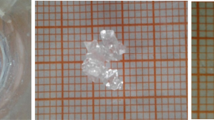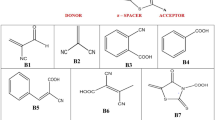Abstract
The 1,8-diaminonaphthalene has various optical applications and electropolymerisation characteristics. The interaction of 1,8-diaminonaphthalene with p-sulfonatocalix[4]arene is studied using absorption, emission, excited state lifetime, and electrochemical techniques. The binding constant values calculated from these techniques are around 102–105 M−1, which emphasizes the efficient binding of 1,8-diaminonaphthalene with p-sulfonatocalix[4]arene. The excited state lifetime is enhanced in the presence of p-sulfonatocalix[4]arene and the propensity of polymerization of 1,8-diaminonaphthalene under electrical environment is inhibited in the presence of p-sulfonatocalix[4]arene. The structure and the mode of binding between 1,8-diaminonaphthalene with p-sulfonatocalix[4]arene complex is studied using 1H NMR and rotating frame overhauser effect spectroscopy (ROESY) techniques.








Similar content being viewed by others
References
Nimse, S.B., Kim, T.: Biological applications of functionalized calixarenes. Chem. Soc. Rev. 42, 366–386 (2013)
Perret, F., Lazar, A.N., Coleman, A.W.: Biochemistry of the p-sulfonatocalix[n]arenes. Chem. Commun. 2425–2438 (2006)
Wang, K., Yang, E.C., Zhao, X.J., Dou, H.X., Liu, Y.: Molecular binding behaviors of sulfonated calixarenes with phenanthrolinediium in aqueous solution and solid state: cavity size governing capsule formation. CrystalGrowthDesign 14, 4631–4639 (2014)
Bagnacani, V., Franceschi, V., Bassi, M., Lomazzi, M., Donofrio, G., Sansone, F., Casnati, A., Ungaro, R.: Arginine clustering on calix[4]arene macrocycles for improved cell penetration and DNA delivery. Nat. Commun. 4, 1721 (2013)
Muthu Mareeswaran, P., Maheshwaran, D., Babu, E., Rajagopal, S.: Binding and fluorescence resonance energy transfer (FRET) of ruthenium(II)-bipyridine-calixarene system with proteins-Experimental and docking studies. J. Fluoresc. 22, 1345–1356 (2012)
Muthu Mareeswaran, P., Babu, E., Rajagopal, S.: Optical recognition of anions by ruthenium (II)-Bbipyridine-calix[4]Arene system. J. Fluoresc. 23, 997–1006 (2013)
Costa, C., Francisco, V., Silva, S.G., do Vale, M.L.C., García-Río, L., Marques, E.F.: Supramolecular self-assembly between an amino acid-based surfactant and a sulfonatocalixarene driven by electrostatic interactions. Colloids. Surf. A 480, 71–78 (2015)
Guo, D.S., Wang, K., Liu, Y.: Selective binding behaviors of p-sulfonatocalixarenes in aqueous solution. J. Incl. Phen. Macro. Chem. 62, 1–21 (2008)
Ashwin, B.M., Vinothini, A., Stalin, T., Muthu Mareeswaran, P.: Synthesis of a safranin T-p-sulfonatocalix[4]arene complex by means of supramolecular complexation. Chem. Select 2, 931–936 (2017)
Madasamy, K., Gopi, S., Senthilkumaran, M., Radhakrishnan, S., Velayutham, D., Muthu Mareeswaran, P., Kathiresan, M.: A supramolecular investigation on the interactions between ethyl terminated bis-viologen derivatives with sulfonatocalix[4]arenes. Chem. Select 2, 1175–1182 (2017)
Harangozó, J.G., Miskolczy. Z., Biczók. L., Wintgens, V., Lorthioir, C.: Effect of host–guest complex formation on the fluorescence of 6-methoxy-1-methyl-quinolinium cation with 4-sulfonatocalix[4]arene: utilization as a fluorescent probe for the study of difenzoquat binding. J. Incl. Phen. Macro. Chem. 81, 377–384 (2015)
Francisco, V., Basilio, N., García-Río, L.: Counterion exchange as a decisive factor in the formation of host-guest complexes by p-sulfonatocalix[4]arene. J. Phys. Chem. B 116, 5308–5315 (2012)
Muthu Mareeswaran, P., Prakash, M., Subramanian, V., Rajagopal, S.: Recognition of aromatic amino acids and proteins with p-sulfonatocalix[4]arene: a luminescence and theoretical approach. J. Phys. Org. Chem. 25, 1217–1227 (2012)
Zhao, H.X., Guo, D.S., Liu, Y.: Binding behaviors of p-sulfonatocalix[4]arene with gemini guests. J. Phys. Chem. B 117, 1978–1987 (2013)
Guo, D.S., Liu, Y.: Supramolecular chemistry of p-sulfonatocalix[n]arenes and its biological applications. Acc. Chem. Res. 47, 1925–1934 (2014)
Hu, X.Y., Peng, S., Guo, D.S., Ding, F., Liu, Y.: Molecular recognition of amphiphilic p-sulfonatocalix[4]arene with organic ammoniums. Supramol. Chem. 27, 336–345 (2015)
Liu, Y.C., Wang, Y.Y., Tian, H.W., Liu, Y., Guo, D.S.: Fluorescent nanoassemblies between tetraphenylethenes and sulfonatocalixarenes: a systematic study of calixarene-induced aggregation. Org. Chem. Front. 3, 53–61 (2016)
Guo, D.S., Uzunova, V.D., Su, X., Liu, Y., Nau, W.M.: Operational calixarene-based fluorescent sensing systems for choline and acetylcholine and their application to enzymatic reactions. Chem. Sci. 2, 1722–1734 (2011)
Kim, H.J., Lee, M.H., Mutihac, L., Vicens, J., Kim, J.S.: Host-guest sensing by calixarenes on the surfaces. Chem. Soc. Rev. 41, 1173–1190 (2012)
Basilio, N., Francisco, V., Garcia-Rio, L.: Aggregation of p-sulfonatocalixarene-based amphiphiles and supra-amphiphiles. Int. J. Mol. Sci. 14, 3140–3157 (2013)
Jiang, B.P., Guo, D.S., Liu, Y.C., Wang, K.P., Liu, Y.: Photomodulated fluorescence of supramolecular assemblies of sulfonatocalixarenes and tetraphenylethene. ACS Nano. 8, 1609–1618 (2014)
Wang, K., Guo, D.S., Zhao, M.Y., Liu, Y.: A supramolecular vesicle bBased on the complexation of p-sulfonatocalixarene with protamine and its trypsin-triggered controllable-release properties. Chem. Eur. J. 22, 1475–1483 (2016)
Raynal, M., Ballester, P., Vidal-Ferran, A., van Leeuwen, P.W.N.M.: Supramolecular catalysis. Part 2: artificial enzyme mimics. Chem. Soc. Rev. 43, 1734–1787 (2014)
Wang, Y.X., Guo, D.S., Duan, Y.C., Wang, Y.J., Liu, Y.: Amphiphilic p-sulfonatocalix[4]arene as drug chaperone for escorting anticancer drugs. Sci. Rep. 5, 9019 (2015)
Danylyuk, O., Butkiewicz, H., Coleman, A.W., Suwinska, K.: Solvent control in the formation of supramolecular host-guest complexes of isoniazid with p-sulfonatocalix[4]arene. CrystEngComm. 17, 1745–1749 (2015)
Temel, H., İlhan, S., Şekerci, M., Ziyadanoğullari, R.: The synthesis and spectral characterization of new Cu(II), Ni(II), Co(III), and Zn(II) complexes with schiff base. Spect. Lett. 35, 219–228 (2002)
Yakuphanoglu, F., Sekerci, M.: Determination of the optical constants of Co(II) complex of schiff base obtained from 1,8-diaminonaphthalene thin film by infrared spectra. J. Mol. Struct. 751, 200–203 (2005)
Bakar, A.F.A., Bahron, H., Kassim, K., Zain, M.M.: Synthesis, characterization and neurotoxicity of schiff bases derived from 1,8-diaminonaphthalene. In: Science and Social Research (CSSR), International Conference, pp 1287–1290 (2010)
Cabeza Javier, A., Nöth, H., Rosales-Hoz M.D.J., Sánchez-Cabrera, G.: Reactivity of triosmium carbonyl clusters with 1,8-diaminonaphthalene: synthesis and structural characterization of amido, diamido, and C-metalated trinuclear derivatives. Eur. J. Inorg. Chem. 2000, 2327–2332 (2000)
Nachtigal, C., Al-Gharabli, S., Eichele, K., Lindner, E., Mayer, H.A.: Structural studies of an array of mixed diamine phosphine ruthenium(II) complexes. Organometallics 21, 105–112 (2002)
Aly, A.A., El-Shaieb, K.M.: Reaction of 1,8-diaminonaphthalene with some selected π-acceptors; prospective optically active non-linear cyanovinylated naphthalenes as well as synthesis of novel perimidin and pleiadene derivatives. Tetrahedron. 60, 3797–3802 (2004)
Al-Betar, A.R., El-Rayyes, A., Klein, U.K.A: Ground and excited states proton transfer reactions of 1,8-diaminonaphthalene in perchloric acid solutions. J. Fluoresc. 15, 689–696 (2005)
Yang, Y., Yin, C., Huo, F., Chao, J., Zhang, Y., Jin, S.: Simple 1,8-diaminonaphthalene-based fluorescence chemosensor for hypochlorites and its practical application. Sensors Actuat. B 199, 226–231 (2014)
Xiong, D., Chen, M., Li, H.: Synthesis of para-sulfonatocalix[4]arene-modified silver nanoparticles as colorimetric histidine probes. Chem. Commun. 880–882 (2008)
Muthu Mareeswaran, P., Babu, E., Sathish, V., Kim, B., Woo, S.I., Rajagopal, S.: p-Sulfonatocalix[4]arene as a carrier for curcumin. New J. Chem. 38, 1336–1345 (2014)
Ackermann, T., Connors, K.A.: Binding constants: the measurement of molecular complex stability. Wiley, New York (1987)
Lakowicz, J.R.: Principles of fluorescence spectroscopy. Springer, New York (2007)
Srinivasan, K., Kayalvizhi, K., Sivakumar, K., Stalin, T.: Study of inclusion complex of β-cyclodextrin and diphenylamine: photophysical and electrochemical behaviors. Spectrochim. Acta A 79, 169–178 (2011)
Paramasivaganesh, K., Srinivasan, K., Manivel, A., Anandan, S., Sivakumar, K., Radhakrishnan, S., Stalin, T.: Studies on inclusion complexation between 4,4′-dihydroxybiphenyl and β-cyclodextrin by experimental and theoretical approach. J. Mol. Struct. 1048, 399–409 (2013)
Diao, G., Zhou, W.: The electrochemical behavior of p-sulfonated calix[4]arene. J. Electroanal. Chem. 567, 325–330 (2004)
Diao, G., Liu, Y.: The electrochemical behavior of p-sulfonated sodium salt of calix[6]arene. Electroanalysis. 17, 1279–1284 (2005)
Skripacheva, V., Burilov, V., Mustafina, A., Kataeva, O., Gruner, M., Yanilkin, V., Stepanov, A., Syakaev, V., Zairov, R., Soloveva, S., Habicher, W., Konovalov, A.: The electrochemical behaviour of [Co(sep)]3+ bound with p-sulfonatothiacalix[4]arene and tetracarboxy-p-sulfonatocalix[4]arene in correlation with inclusive and non-inclusive binding modes. J. Incl. Phen. Macro. Chem. 69, 191–199 (2011)
Acknowledgements
We acknowledge the financial support of Department of science and Technology (DST INSPIRE) [Project number—IFA14/CH-147], India.
Author information
Authors and Affiliations
Corresponding author
Electronic supplementary material
Below is the link to the electronic supplementary material.
Rights and permissions
About this article
Cite this article
Saravanan, C., Senthilkumaran, M., Ashwin, B.C.M.A. et al. Spectral and electrochemical investigation of 1,8-diaminonaphthalene upon encapsulation of p-sulfonatocalix[4]arene. J Incl Phenom Macrocycl Chem 88, 239–246 (2017). https://doi.org/10.1007/s10847-017-0729-1
Received:
Accepted:
Published:
Issue Date:
DOI: https://doi.org/10.1007/s10847-017-0729-1




